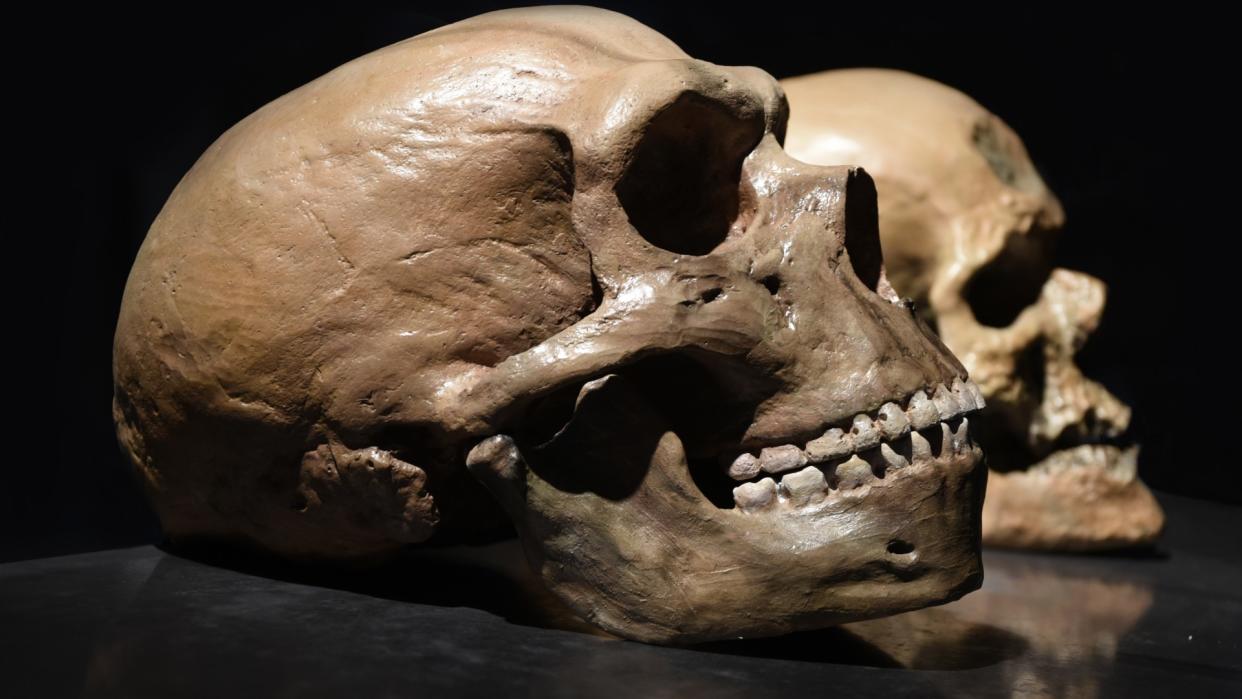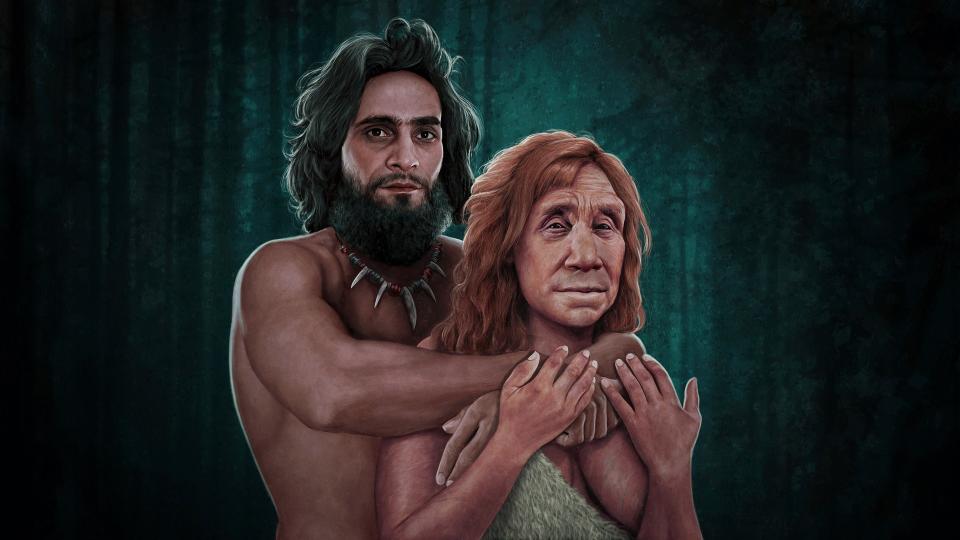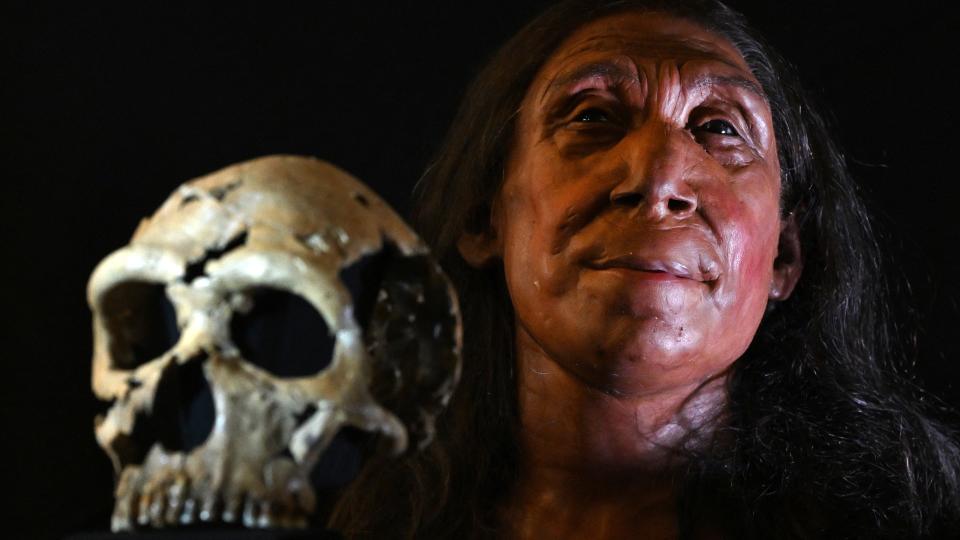What's the difference between Neanderthals and Homo sapiens?

Neanderthals were modern humans' closest relatives, and the two types of humans lived in many of the same habitats and interbred multiple times before our cousins died out around 40,000 years ago, which is why some Neanderthal DNA still lives in most Eurasians today.
Yet despite this closeness, Neanderthals' (Homo neanderthalensis) and Homo sapiens' lineages diverged sometime between 400,000 and 800,000 years ago, and the two species differed in many ways.
Here are some of the key ways our closest human relatives were different from us.
Related: Neanderthal woman's face brought to life in stunning reconstruction
Facial features
If you were traveling on the subway in New York and met a Neanderthal, you'd probably recognize them immediately, Shara Bailey, a professor of biological anthropology at New York University, told Live Science. That's because of their distinctive facial features.
At first glance, you'd likely notice they have a sloping forehead with very big, arched brow ridges, she said. Their nose would be wider and more prominent than those of modern humans, and their skull would be a little bit more elongated, she added.
When seen from the side, Neanderthals also had noticeably smaller chins, and their front teeth were bigger compared with our teeth, Chris Stringer, a research leader in human evolution at the Natural History Museum in London, told Live Science.
Neanderthal DNA lives in us

'More Neanderthal than human': How your health may depend on DNA from our long-lost ancestors
Read more:
—10 unexpected ways Neanderthal DNA affects our health
—The mystery of the disappearing Neanderthal Y chromosome
Although Neanderthals had similar size brains to H. sapiens, their skull shape differed from ours.
"Our skulls tend to be high and rounded, globular in terms of the shape of the braincase, whereas Neanderthal skulls, like those of most other early humans, are long and low," Stringer said.
Neanderthal skulls often have a projection on the occipital bone at the base of the skull. If you tie your hair into a bun at the back, this is roughly where this bone is located in our extinct cousins. In the middle of the Neanderthal skull's occipital bone is a little depression called the suprainiac fossa, which is a distinctive feature of this population, although scientists don't know what purpose it served Stringer said.
Neanderthal ear bones are also shaped differently from ours, he said.
Body shape
Neanderthals could walk upright on two feet, and their skeletons were quite similar to ours, Stringer said.
On average, they were around 4 feet 11 inches (150 centimeters) to 5 ft 7 inches (170 cm) tall. This is around 4.7 to 5.5 inches (12 to 14 cm) shorter than post-World-War II Europeans, but identical or slightly taller than Europeans 20,000 or even 100 years ago.
Neanderthals were very muscular, broad-shouldered and barrel-chested, with wide hips that flared out, Stringer said. Research suggests they had a 20% larger lung capacity than modern humans.
Neanderthal limbs were also proportioned differently from modern humans — the lower segments of their arms and legs were relatively short compared with the upper segments, Stringer said. This gave them a stocky appearance. Similar features are also seen in modern humans who live in colder climates, with a shorter, wider body being an adaptation to reduce surface area and conserve heat.

Behavior
Like all early humans, life would have been pretty hard for Neanderthals, which helped shape their appearance.
"They're living off the land, they're having to move around a lot and use a lot of muscle power," Stringer said. Their skeletons, which were built for strength and durability, helped them to withstand their physically demanding lifestyle, he said.
H. sapiens also faced these challenges, but have lighter skeletons, probably in part because they made tools and had cultural adaptations, such as long-distance trade, which made their physical lives a little easier.
"Obviously, the more complex your technology is, the more it can take the weight off the skeleton in your everyday activities," Stringer said.
In terms of their behavior, Neanderthals were likely very similar to us overall, he added. For instance, they seemed to bury their dead and care for sick individuals. They also lived in caves, formed small communities, made fires, and may have had language.
"They may have died relatively early compared with us, so maybe grandmothers and great grandparents were a rarity compared with Homo sapiens," Stringer said.
Diet
Neanderthals are believed to have eaten both meat and plant-based foods, such as hard seeds and nuts. However, those living in colder climates likely relied on a meatier diet than those in warmer regions.
Neanderthals are known to have hunted big and medium-size game, but they didn't use long-range projectile weapons, Bailey said. Instead, they most likely used a technique called ambush hunting — essentially hiding in a bush before jumping out and stabbing an animal with a thrusting spear.
Neanderthals probably also wore some clothing, such as animal skin over the shoulders or around the waist, depending on where they lived, Bailey said. H. sapiens reached higher latitudes than Neanderthals, so in those places, anatomically modern humans would've needed more specialized clothing, she said.
Nevertheless, while scientists tend to say that modern humans did one thing and Neanderthals did another, it's important to remember that H. sapiens didn't always do these things, Bailey said.
"The earliest Homo sapiens were actually behaving a lot like Neanderthals so the differences between the two really come later," she said. For example, when the earliest H. sapiens left Africa, around 200,000 years ago, they were probably using the same types of stone tools that Neanderthals were, she said. It wasn't until approximately 50,000 years ago that there was an "explosion" of culture in H. sapiens.
Likewise, to say that all Neanderthals did or had the capacity to do certain things is, in Bailey's view, a mistake. This is especially true considering how long Neanderthals lived and the vast geographical area that they inhabited, she said.
Ever wonder why some people build muscle more easily than others or why freckles come out in the sun? Send us your questions about how the human body works to community@livescience.com with the subject line "Health Desk Q," and you may see your question answered on the website!

